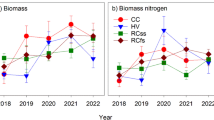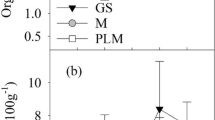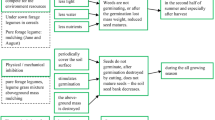Abstract
There is not sufficient knowledge concerning the risks involved in NO3–N leaching in relation to the use of cover crops and mulches. A 2 year field experiment was carried out in a pepper (Capsicum annuum L.) crop transplanted into different soil management treatments which involved the addition of mulch of three different types of winter cover crops (CC) [hairy vetch (Vicia villosa Roth.), subclover (Trifolium subterraneum L.), and a mixture of hairy vetch/oat (Avena sativa L.)], and an un-mulched plot. At the time of CC conversion into mulch, the hairy vetch/oat mixture accumulated the highest aboveground biomass (5.30 t ha−1 of DM), while hairy vetch in pure stand accumulated the highest quantity of N (177 kg ha−1) and showed the lowest C/N ratio (12). The marketable pepper yield was higher in mulched than in conventional (on average 33.5, 28.9, 27.7 and 22.2 t ha−1 of FM for hairy vetch, subclover, hairy vetch/oat mixture, and conventional, respectively). Generally, the NO3–N content of the soil was minimum at CC sowing, slightly higher at pepper transplanting and maximum at pepper harvesting (on average 15.2, 16.8, and 23.3 mg NO3-N kg−1 of dry soil, respectively). The cumulative leachate was higher during the CC period (from October to April) than the pepper crop period (from April to September), on average 102.1 vs 66.1 mm over the years, respectively. The cumulative NO3–N leached greatly depended on the type of mulch and it was 102.3, 95.3, 94.7, and 48.2 kg ha−1 in hairy vetch, subclover, hairy vetch/oat mixture, and conventional, respectively. A positive linear correlation was found between the N accumulated in the CC aboveground biomass and the NO3–N leached during pepper cultivation (R 2 = 0.87). This research shows that winter legume cover crops, especially hairy vetch in pure stand, converted into dead mulch in spring could be used successfully for adding N to the soil and increasing the yield of the following pepper crop although the risks of N losses via leaching could be increased compared to an un-mulched soil. Therefore when leguminous mulches are used in the cultivation of a summer crop, appropriate management practices of the system, such as a better control of the amount of irrigation water and the cultivation of a graminaceous or a cruciferous catch crop after the harvesting of the summer crop, should be adopted in order to avoid an increase in NO3–N leaching.








Similar content being viewed by others
References
Abdul-Baki AA, Teasdale JR (2007) Sustainable production of fresh market tomatoes and other vegetables with cover crop mulches ASDA-ARS Farmers’ Bull No, 2280, 31 p
Al-Kaisi M, Licht MA (2004) Effect of strip tillage on corn nitrogen uptake and residual soil nitrate accumulation compared with no-tillage and chisel plow. Agron J 96:1164–1171
Allen RG, Pereira LS, Raes D, Smith M (1998) Crop Evapotranspiration—Guidelines for computing crop water requirements. Irrigation and drainage paper no. 56. FAO, Rome
Berntsen J, Olesen JE, Petersen BM, Hansen EM (2006) Long-term fate of nitrogen uptake in catch crops. Eur J Agron 25:383–390
Bond W, Grundy AC (2001) Non- chemical weed management in organic farming systems. Weed Res 41:383–405
Brennan EB, Smith RF (2005) Winter cover crop growth and weed suppression on the central coast of California. Weed Technol 19:1017–1024
Cabrera ML, Kissel DE, Vigil MF (2005) Nitrogen mineralization from residues: research opportunities. J Environ Qual 34:75–79
Campiglia E, Caporali F, Radicetti E, Mancinelli R (2010a) Effect of cover crops and mulches on weed control and nitrogen fertilization in Tomato (Lycopersicon esculentum Mill.). Crop Prot 29:354–363
Campiglia E, Caporali F, Radicetti E, Mancinelli R (2010b) Hairy vetch (Vicia villosa Roth.) cover crop residue management for improving weed control and yield in no-tillage tomato (Licopersicon esculentum Mill.) production. Europ J Agron 33:94–102
Cataldo DA, Haroon M, Schrader LE, Young V (1975) Rapid colorimetric determination of nitrate in plant tissue by nitration of salycilic acid. Commun Soil Sci Plan Anal 6:71–80
Constantin J, Mary B, Laurent F, Aubrion G, Fontaine A, Kerveillant P, Beaudoin N (2010) Effects of catch crops, no till and reduced nitrogen fertilization on nitrogen leaching and balance in three long-term experiments. Agric Ecosys Environ 135:268–278
Coppens F, Garnier P, Findeling A, Merckx R, Recous S (2007) Decomposition of mulched versus incorporated crop residues: modeling with PASTIS clarifies interactions between residue quality and location. Soil Biol Biochem 39:2339–2350
Crew TE, Peoples MB (2004) Legume versus fertilizer sources of nitrogen: ecological tradeoffs and human needs. Agr Ecosyst Environ 102:279–297
Doane TA, Horwath WR, Mitchell JP, Jackson J, Miyao G, Brittan K (2009) Nitrogen supply from fertilizer and legume cover crop in the transition to no-tillage for irrigated row crops. Nutr Cycl Agroecosyst 85:253–262
Gomez KA, Gomez AA (1984) Statistical procedures for agricultural research, 2nd edn. Jhon & son, New York
Hartwig NL, Ammon HU (2002) Cover crops and living mulches. Weed Sci 50:688–699
Hooker KV, Coxon CE, Hackett R, Kirwan LE, O’Keeffe E, Richerds KG (2008) Evaluation of cover crop and reduced cultivation for reducing nitrate leaching in Ireland. J Environ Qual 37:138–145
Ibewiro B, Sanginge N, Vanlauwe B, Merckx R (2000) Nitrogen contributions from decomposing cover crop residue to maize in tropical derived savanna. Nutr Cycl Agroecosyst 57:131–140
Isik D, Kaya E, Mgouajio M, Mennan H (2009) Weed suppression in organic pepper (Capsicum annuum L.) with winter cover crops. Crop Prot 28:356–363
Kramberger B, Gselman A, Janzekovic M, Kaligaric M, Brako B (2009) Effects of cover crops on soil mineral nitrogen and on the yield and nitrogen content of maize. Europ J Agronomy 31:103–109
Kuo S, Jellum J (2002) Influence of winter cover crop and residue management on soil nitrogen availability. Agron J 94:501–508
Kuo S, Sainju UM, Jellum EJ (1997) Winter cover cropping influence on nitrogen in soil. Soil Sci Soc Am J 61:145–152
Martinez J, Guiraud G (1990) A lysimeter study of the effects of a ryegrass catch crop, during a winter wheat/maize rotation, on nitrate leaching and on the following crop. J Soil Sci 41:5–16
McCracken DV, Smith MS, Grove JH, Mackown CT, Blevins RL (1994) Nitrate leaching as influenced by cover cropping and nitrogen source. Soil Sci Soc Am J 58:1476–1483
Mitchell RDJ, Harrison R, Russel KJ, Webb J (2000) The effect of crop residue incorporation date on soil inorganic nitrogen, nitrate leaching and nitrogen mineralization. Biol Fertil Soils 32:294–301
Möller K, Reents HJ (2009) Effects of various cover crops after peas on nitrate leaching and nitrogen supply to succeeding winter wheat or potato crops. J Plant Nutr Soil Sci 172:277–287
Möller K, Stinner W, Leithold G (2008) Growth, composition, biological N2 fixation and nutrient uptake of a leguminous cover crop mixture and the effect of their removal on field nitrogen balances and nitrate leaching risk. Nutr Cycl Agroecosyst 82:233–249
Nakhone LN, Tabatabai MA (2008) Nitrogen mineralization of leguminous crops in soils. J Plant Nutr Soil Sci 171:231–241
Nelson DW, Sommers LE (1996) Total carbon, organic carbon, and organic matter. In: sparks DL, Page AL, Helmke PA, Leoppert RH, Soltanpuor PN, Tabatabai MA, Johnson CT, Sumner ME (eds) Methods of soil analysis. Part 3, chemical methods. SSSA book series, vol 5. American Society of Agronomy and Soil Science Society of America, Madison, WI, pp 961–1010
Quemada M (2004) Predicting crop residue decomposition using moisture adjusted time scales. Nutr Cycl Agroecosyst 70:283–291
Rocecrance RC, McCarty GW, Shelton DR, Teasdale JR (2000) Denitrification and N mineralization from hairy vetch (Vicia villosa Roth.) and rye (Secale cereale L.) cover crop monocultures and biculture. Plant Soil 227:283–290
Romic D, Romic M, Borosic J, Poljak M (2003) Mulching decreases nitrate leaching in bell pepper (Capsicum annuum L.) cultivation. Agr Water Manage 60:87–97
Ruffo ML, Bollero GA (2003) Modelling rye and hairy vetch residue decomposition as a function of degree-days and decomposition-day. Agron J 95:900–907
Sainju UM, Whitehead WF, Singh BP (2005) Biculture legume-cereal cover crops for enhanced biomass yield and carbon and nitrogen. Agron J 97:1403–1412
Sainju UM, Whitehead WF, Singh BP, Wang S (2006) Tillage, cover crops, and nitrogen fertilization effects on soil nitrogen and cotton and sorghum yields. Europ J Agronomy 25:372–382
Sainju UM, Singh BP, Whiteead WF, Wang S (2007) Accumulation and crop uptake of soil mineral nitrogen as influenced by tillage, cover crops, and nitrogen fertilization. Agron J 99:682–691
Sainju UM, Caesar-Tonthat T, Lenssen AW, Evans RG, Kolberg R (2009) Tillage and cropping sequence impacts on nitrogen cycling in dryland farming in eastern Montana, USA. Soil Till Res 103:332–341
SAS (1996) User’s guide: statistics. SAS Institute, Cary, NC
Seo JH, Meisinger JJ, Lee HJ (2006) Recovery of nitrogen-15-labeled hairy vetch and fertilizer applied to corn. Agron J 98:245–254
Shipley PR, Meisinger JJ, Decker AM (1992) Conserving residual corn fertilizer nitrogen with winter cover crops. Agron J 84:869–876
Sincik M, Turan M, Göksoy T (2008) Responses of potato (Solanum tuberosum L.) to green manure cover crops and nitrogen fertilization rates. Am J Pot Res 85:150–158
Smill V (1999) Nitrogen in crop production: an account of global flows. Global Biogeochem Cycles 13:647–662
Teasdale JR, Shirley DW (1998) Influence of herbicide application timing on corn production in a hairy vetch cover crop. J Prod Agric 11:121–125
Teasdale JR, Devine TE, Mosjidis JA, Bellinder RR, Beste CE (2004) Growth and development of hairy vetch cultivars in the Northeastern United States as influenced by planting and harvesting date. Agron J 96:1266–1271
Teasdale JR, Abdul-Baki AA, Bong Park Y (2008) Sweet corn production and efficiency of nitrogen use in high cover crop residue. Agron Sustain Dev 28:559–565
Vos J, van der Putten PEL (1997) Field observations on nitrogen catch crops. I. Potential and actual growth and nitrogen accumulation in relation to sowing date and crop species. Plant Soil 195:299–309
Vos J, van der Putten PEL (2004) Nutrient cycling in a cropping system with potato, spring wheat, sugar beet, oats and nitrogen catch crops. II. Effect of catch crops on nitrate leaching in autumn and winter. Nutr Cycl Agroecosyst 70:23–31
Wagger MG (1989) Time of dissection effects on plant composition and subsequent nitrogen release from several winter annual cover crops. Agron J 81:236–241
Zotarelli L, Sholberg JM, Dukes MD, Munõz-Carpena R (2007) Monitoring of nitrate leaching in sandy soils: comparison of three methods. J Environ Qual 36:953–962
Acknoledgement
The authors would like to thank Mr. Claudio Stefanoni for his technical assistance. This work was partially funded by the University of Tuscia.
Author information
Authors and Affiliations
Corresponding author
Rights and permissions
About this article
Cite this article
Campiglia, E., Mancinelli, R., Radicetti, E. et al. Legume cover crops and mulches: effects on nitrate leaching and nitrogen input in a pepper crop (Capsicum annuum L.). Nutr Cycl Agroecosyst 89, 399–412 (2011). https://doi.org/10.1007/s10705-010-9404-2
Received:
Accepted:
Published:
Issue Date:
DOI: https://doi.org/10.1007/s10705-010-9404-2




